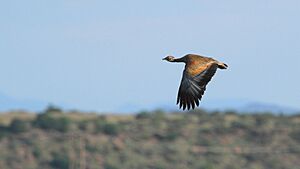Blue korhaan facts for kids
Quick facts for kids Blue korhaan |
|
|---|---|
 |
|
| Male in the Mountain Zebra National Park, Eastern Cape, South Africa | |
| Conservation status | |
| Scientific classification | |
| Genus: |
Eupodotis
|
| Species: |
caerulescens
|
The blue korhaan or blue bustard (Eupodotis caerulescens) is a type of bird found only in South Africa. It belongs to the Otididae family, which includes birds called bustards. This bird makes a sound like a frog croaking, often while it is flying. It likes to live in open areas like grasslands, dry shrubland, and even on farms. It especially prefers places with short grass and flat ground.
Contents
What Does the Blue Korhaan Look Like?

Korhaans are birds that spend most of their time on the ground. They have strong bodies, big heads, and long necks. Their legs are long, but their toes are short. The blue korhaan is a fairly large bird. It grows to be about 50 to 58 cm (20 to 23 in) long.
Colors and Markings
The top of its head, called the forehead and crown, is black. The sides of its head are white. Male blue korhaans have brown backs, wings, and tails. Their necks, throats, chests, and bellies are a pretty bluish-grey color.
Female blue korhaans look similar to males. However, their necks and undersides are a duller grey. Their ear coverts (feathers covering the ears) are a light brown color, called buff. Both males and females have yellow legs and feet.
Its Unique Call
The blue korhaan makes a throaty sound that sounds like "krok-kau." You can often hear this call around sunrise. They usually make this sound while they are flying.
Where Do Blue Korhaans Live?
The blue korhaan lives in South Africa and a small part of western Lesotho. Its home range stretches from cities like Pretoria and Mbombela in the north. It goes south to Bhisho. This whole area is about 356,000 km² (137,000 mi²).
Preferred Habitats
These birds are found in grasslands. They live at high altitudes, usually between 1,500 and 3,000 m (4,900 and 9,800 ft) above sea level. They like short grass with some small, bush-like plants. They also prefer areas with termite mounds but not many trees. Blue korhaans usually stay within one kilometer of water. They can also be found in old farm fields and areas where winter crops or pastures are grown.
How Do Blue Korhaans Live?
Blue korhaans mostly stay on the ground. If something bothers them, they will crouch down low. If you get closer, they usually walk or run away with their heads down. However, if they feel very scared, they will fly away for a long distance.
Social Life and Diet
These birds usually live in pairs or in small family groups. They search for food on the ground. Their diet includes insects, small lizards, scorpions, seeds, flowers, and leaves.
Breeding Habits
Blue korhaans mainly lay their eggs in October and November. Their nest is a simple dip in the ground. They often make their nest in thick plants to hide it. A female will lay one to three eggs. The eggs hatch after about 26 days. The young birds may stay with their family for up to two years.
Is the Blue Korhaan in Danger?
In 2017, experts estimated there were between 8,000 and 10,000 adult blue korhaans. In some areas, like the Eastern Karoo, their numbers seem to be going down. But in other places, their population seems to be stable.
Threats to Their Home
The International Union for Conservation of Nature (IUCN) says that the places where blue korhaans live are shrinking. This is because grasslands are being turned into farms. This problem is expected to continue. Because of this, the IUCN has listed the blue korhaan as "near threatened." This means they could become endangered in the future if things don't change.
Images for kids




